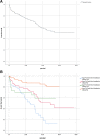Influencing factors on morbidity and mortality in intertrochanteric fractures
- PMID: 37495718
- PMCID: PMC10372085
- DOI: 10.1038/s41598-023-38667-9
Influencing factors on morbidity and mortality in intertrochanteric fractures
Abstract
We aimed to evaluate the effect of the patient's clinical and paraclinical condition before and after surgery on short-term mortality and complication and long-term mortality. A retrospective cohort study was conducted and multivariate logistic regression was applied to determine the effect of demographic characteristics (sex, age, AO/OTA classification, height, weight, body mass index), medical history (hypertension, ischemic heart disease, diabetes mellitus, thyroid malfunction, cancer, osteoporosis, smoking) lab data (Complete blood cell, blood sugar, Blood Urea Nitrogen, Creatinine, Na, and K), surgery-related factors (Anesthesia time and type, implant, intraoperative blood transfusion, postoperative blood transfusion, and operation time), duration of admission to surgery and anticoagulant consumption on short-term mortality and complication and long-term mortality. Three hundred ten patients from November 2016 to September 2020 were diagnosed with an intertrochanteric fracture. 3.23% of patients died in hospital, 14.1% of patients confronted in-hospital complications, and 38.3% died after discharge till the study endpoint. ΔNumber of Neutrophiles is the primary determinant for in-hospital mortality in multivariate analysis. Age and blood transfusion are the main determinants of long-term mortality, and Na before surgery is the primary variable associated with postoperative complications. Among different analytical factors Na before surgery as a biomarker presenting dehydration was the main prognostic factor for in hospital complications. In hospital mortality was mainly because of infection and long-term mortality was associated with blood transfusion.
© 2023. The Author(s).
Conflict of interest statement
The authors declare no competing interests.
Figures


Similar articles
-
Analysis of one-year postoperative mortality and risk factors of elderly patients with intertrochanteric fractures after PFNA.Niger J Clin Pract. 2022 Sep;25(9):1557-1562. doi: 10.4103/njcp.njcp_109_22. Niger J Clin Pract. 2022. PMID: 36149219
-
[Correlation between metabolic syndrome and adverse events after internal fixation of femoral intertrochanteric fracture in the elderly].Zhongguo Gu Shang. 2021 Oct 25;34(10):901-5. doi: 10.12200/j.issn.1003-0034.2021.10.003. Zhongguo Gu Shang. 2021. PMID: 34726015 Chinese.
-
A comparative study of the therapeutic effect between long and short intramedullary nails in the treatment of intertrochanteric femur fractures in the elderly.Chin J Traumatol. 2015;18(6):332-5. doi: 10.1016/j.cjtee.2015.12.001. Chin J Traumatol. 2015. PMID: 26917023
-
[Trochanteric femoral fractures].Acta Chir Orthop Traumatol Cech. 2013;80(1):15-26. Acta Chir Orthop Traumatol Cech. 2013. PMID: 23452417 Review. Czech.
-
In-hospital mortality risk of intertrochanteric hip fractures: a comprehensive review of the US Medicare database from 2005 to 2010.Musculoskelet Surg. 2017 Dec;101(3):213-218. doi: 10.1007/s12306-017-0470-3. Epub 2017 Mar 2. Musculoskelet Surg. 2017. PMID: 28255840 Review.
Cited by
-
Factors associated with postoperative quality of life in patients with intertrochanteric fracture.Ann Med Surg (Lond). 2023 Dec 11;86(2):703-711. doi: 10.1097/MS9.0000000000001608. eCollection 2024 Feb. Ann Med Surg (Lond). 2023. PMID: 38333317 Free PMC article.
-
Association of preoperative blood biomarkers with postoperative major adverse cardiac events and mortality in major orthopaedic surgery: a systematic review and meta-analysis.BMJ Open. 2025 Jan 15;15(1):e086263. doi: 10.1136/bmjopen-2024-086263. BMJ Open. 2025. PMID: 39819956 Free PMC article.
-
Construction and validation of a predictive model for the risk of prolonged preoperative waiting time in patients with intertrochanteric fractures.Front Med (Lausanne). 2025 Jan 17;11:1503719. doi: 10.3389/fmed.2024.1503719. eCollection 2024. Front Med (Lausanne). 2025. PMID: 39895817 Free PMC article.
-
Functional Outcomes and Quality of Life in Elderly Patients Following Intertrochanteric Femur Fracture: A One-Year Follow-Up Study.Bull Emerg Trauma. 2025;13(1):25-31. doi: 10.30476/beat.2025.104314.1546. Bull Emerg Trauma. 2025. PMID: 40303654 Free PMC article.
-
Respiratory Complications Are the Main Predictors of 1-Year Mortality in Patients with Hip Fractures: The Results from the Alzira Retrospective Cohort Study.Geriatrics (Basel). 2024 Apr 9;9(2):47. doi: 10.3390/geriatrics9020047. Geriatrics (Basel). 2024. PMID: 38667514 Free PMC article.
References
MeSH terms
LinkOut - more resources
Full Text Sources
Medical
Miscellaneous

